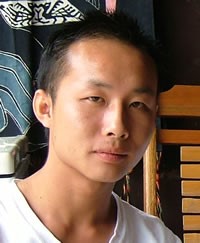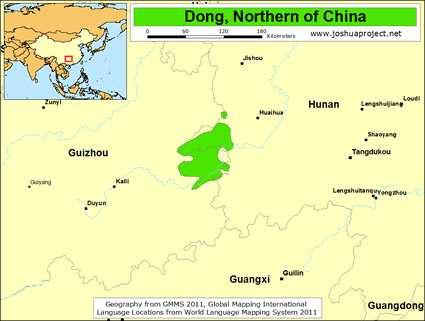Although the Northern and Southern Dong speak different languages, they have been combined to form the official Dong nationality in China. The two groups are also culturally different. The Northern Dong have been assimilated into Chinese culture much more than their southern counterparts. The Dong call themselves Kam.
The Dong were not known by that name until this century. In the past they were part of the ancient Yue peoples, which dominated southern China. The Dong have many ancient myths and legends about the origin of the world.
One of the visually striking aspects of a Dong community is the Drum Tower. For centuries, the Dong have used the tower as the rallying point of the community: a place where the village gathers for an emergency, celebrates a wedding, and where young Dong couples sing love songs to each other. One source states that there are more than 30 distinct Dong dialect groups in China, and that marriage is rare between members of the various groups.
The Dong believe in many gods. They regard certain mountains, trees, stones, and other nonhuman objects as sacred. This is reflected in the Dong custom of planting a fir tree for each newborn baby. Some Dong in remote areas practice a form of black magic called Tu. The Dong worship the kitchen god during the Spring and Fall festivals. A growing number of Dong youth are nonreligious.
Although they are considered relatively open to the gospel, the Dong remain one of the most neglected minority groups in China. Today there are an estimated 600 Northern Dong Christians, a meager number considering their large population of more than one million. Most Dong have never heard the gospel. Both Protestant and Catholic missionaries were active among the Dong prior to the introduction of communism in 1949. Several churches were built, but the gospel never took a firm hold among the Dong. Efforts are underway to produce a Roman script for them. Many Northern Dong could now be reached by Chinese-language media.
Northern Dong people in Chinas will be lost in this life and the life to come without the guidance of Lord Jesus. They need someone to go to them representing Christ.
Pray for the Lord to intervene in their families as he calls them to his side.
Pray for workers who love them.
Pray for them to be drawn to the Lord of lords.
Pray for a growing movement of church planting in their communities.
Scripture Prayers for the Dong, Northern in China.
Operation China, Asia Harvest, Copyrighted © Used with permission.
| Profile Source: Joshua Project |











